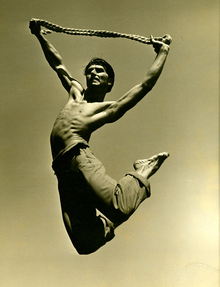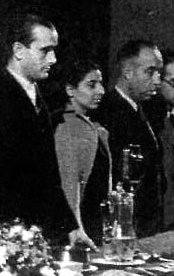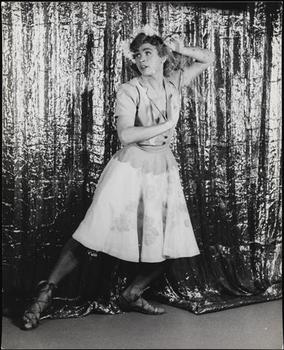Related Research Articles

Isidora Dolores Ibárruri Gómez, also known as Pasionaria, was a Spanish Republican politician during the Spanish Civil War (1936–1939) and a communist. She is renowned for her slogan ¡No Pasarán!, which she issued during the Battle for Madrid in November 1936.

Agnes George de Mille was an American dancer and choreographer.

Martha Graham was an American modern dancer and choreographer, whose style, the Graham technique, reshaped American dance and is still taught worldwide.

Helen Tamiris was an American choreographer, modern dancer, and teacher.

Martha Hill was an American dance instructor with wide influence. She founded innovative programs at Bennington College and Connecticut College, and was the first Director of Dance at the Juilliard School, a position she held for almost 35 years.
Medea, Op. 23, (1946) is a ballet suite by American composer Samuel Barber. It was commissioned by the Ditson Fund of Columbia University for Martha Graham and was premiered on 10 May 1946, at Columbia University's McMillin Theater, New York City. The ballet was originally called Serpent Heart, but the work was revised in 1947 and retitled Cave of the Heart. Costumes were designed by Edythe Gilfond and the set was created by Isamu Noguchi. The original cast list included Graham, Erick Hawkins, Yuriko, May O'Donnell, and other members of the Martha Graham Dance Company.

Frederick "Erick" Hawkins was an American modern-dance choreographer and dancer.

Modern dance is a broad genre of western concert or theatrical dance which includes dance styles such as ballet, folk, ethnic, religious, and social dancing; and primarily arose out of Europe and the United States in the late 19th and early 20th centuries. It was considered to have been developed as a rejection of, or rebellion against, classical ballet, and also a way to express social concerns like socioeconomic and cultural factors.

Irene Rodríguez, née Irene Carlota Berta Lewy y Rodríguez was a Spanish journalist, feminist, pacifist and Communist activist. For many years she was the assistant of Dolores Ibárruri, leader of the Spanish Communist Party, and she is best known for this role. After the Spanish Civil War she was forced into exile in Moscow and Beijing. She returned to Spain after the return to democracy in 1977.

Encarnación Fuyola Miret was a Spanish teacher and Communist activist who played a significant role as a propagandist in the period leading up to and during the Spanish Civil War. Later she went into exile in Mexico.
Deaths and Entrances is a ballet choreographed by Martha Graham performed to music by Hunter Johnson. Arch Lauterer created the original set; Edythe Gilfond designed the costumes. The ballet was well-received from the first performance despite being labeled as one of Graham's most personal, least accessible works. Oscar de la Renta created new costumes for the ballet's 2005 revival. The piece premiered on July 18, 1943, at Bennington College in Bennington, Vermont. The first performance was an informal preview for which the dancers wore practice clothes although the set was in place.
Punch and the Judy is a comic ballet about marital discord choreographed by Martha Graham to music by Robert McBride. Arch Lauterer designed the set, Charlotte Trowbridge, the costumes. Edward Gordon Craig provided text for the narrated portions. The piece premiered on August 10, 1941, at the Bennington College Theatre in Bennington, Vermont.
Lamentation is a modern dance solo choreographed by Martha Graham to Zoltán Kodály's 1910 Piano Piece, Op. 3, No. 2. One of Graham's signature works, it premiered on January 8, 1930 at Maxine Elliott's Theatre in New York City. The performance was part of a concert staged by the Dance Repertory Theatre, a group that included dancer/choreographers Doris Humphrey, Charles Weidman and Helen Tamiris. Their stated goal was "to give annually a season of continuous dance programs which will be representative of the art of dance in America and will give native artists an outlet for their creative work."
Harlequinade was a solo modern dance by Martha Graham set to music by Ernst Toch. The work premiered on January 8, 1930, at Maxine Elliott's Theatre in New York City. The performance was part of a concert staged by the Dance Repertory Theatre, a group that included dancer/choreographers Doris Humphrey, Charles Weidman and Helen Tamiris. Their stated goal was "to give annually a season of continuous dance programs which will be representative of the art of dance in America and will give native artists an outlet for their creative work." Other new Graham works on the evening's program were Lamentation and Prelude to a Dance.
Bacchanale was an ensemble work created by Martha Graham to music by Wallingford Riegger. It premiered on February 2, 1931, at the Craig Theatre in New York City. The work was danced by Martha Graham and Group, the forerunner of the Martha Graham Dance Company.
Deep Song, a solo modern dance by Martha Graham, premiered on December 19, 1937, at the Guild Theatre in New York City. Performed to music by Henry Cowell, the piece was the second work created by Graham in response to the Spanish Civil War. The first, Immediate Tragedy, was introduced in 1937.
Chronicle is a modern dance work choreographed by Martha Graham to music by Wallingford Riegger. It premiered on December 20, 1936, at the Guild Theatre in New York City. The set was designed by Isamu Noguchi. Riegger's music was scored for piano, wind instruments and percussion; Noguchi's set was made up primarily of curtains, platforms and stairs. The original production was danced by Martha Graham and Group, the forerunner of the Martha Graham Dance Company. According to the program notes, the dance is based upon "the advent and consequences of war" and concerned itself with the "contemporary situation", referring to the impending conflict in Europe.
Course was a modern dance work choreographed by Martha Graham to music by George Antheil. The piece sometimes appeared on programs as Course: One in Red; Three in Green; Two in Blue; Two in Red. It premiered on February 10, 1935, at the Guild Theatre in New York City. The ballet was performed by Martha Graham and Group, the forerunner to the Martha Graham Dance Company.
Opening Dance was a modern dance solo choreographed by Martha Graham to music by Norman Lloyd. It premiered on July 30, 1937, at the Bennington School of the Dance in Bennington, Vermont.

Edgar Nelson Barclift was an American choreographer and dancer. As a member of the United States Army's Theatre Section during the Second World War, he was the co-choreographer and principal dancer of Irving Berlin's This Is The Army (1942). He choreographed the musical Around the World (1946). He became the romantic partner of the composer and songwriter Cole Porter in the early 1940s.
References
- ↑ "Immediate Tragedy (Ballet choreographed by Martha Graham)". Performing Arts Encyclopedia, Library of Congress. Retrieved 29 January 2016.
- 1 2 Franko, Mark (May 8, 2002). Martha Graham in Love and War (eBook ed.). Oxford University Press. pp. 14–18. ISBN 0-19977766-7.
- ↑ Hofmann, Paul (November 13, 1989). "Dolores Ibarruri, 'La Pasionaria' Of Spanish Civil War, Dies at 93; An Indomitable Leftist". The New York Times. Retrieved 29 January 2016.
- 1 2 3 Bird, Dorothy; Greenberg, Joyce (September 15, 2002). Birds Eye View: Dancing With Martha Graham And On Broadway (Paperback ed.). University of Pittsburgh Press. p. 116. ISBN 978-0822957911.
- ↑ Mansfield Soares, Janet (1992). Louis Horst: Musician in a Dancer's World . Duke University Press. pp. 135–137. ISBN 0-8223-1226-3.
- ↑ Martin, John (August 15, 1937). "Festival Notes: Martha Graham Premiere". The New York Times. Retrieved 29 January 2016.
- ↑ Graff, Ellen (July 9, 1997). Stepping Left: Dance and Politics in New York City, 1928–1942 (First ed.). Duke University Press Books. pp. 120–124. ISBN 978-0822319481.